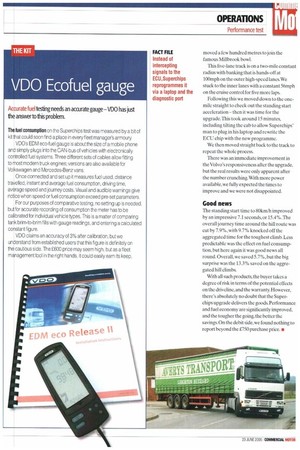VDO Ecofuel gauge
Page 65

If you've noticed an error in this article please click here to report it so we can fix it.
Accurate fuel testing needs an accurate gauge -1/DO has just the answer to this problem.
The fuel consumption on the Superchips test was measured by a bit of kit that could soon find a place in every fleet manager's armoury.
VDO's EDM eco-fuel gauge is about the size of a mobile phone and simply plugs into the CAN-bus of vehicles with electronically controlled fuel systems. Three different sets of cables allow fitting to most modern truck engines; versions are also available for Volkswagen and Mercedes-Benz vans.
Once connected and set up it measures fuel used, distance travelled, instant and average fuel consumption, driving time, average speed and journey costs. Visual and audible warnings give notice when speed or fuel consumption exceed pre-set parameters.
For our purposes of comparative testing, no setting up is needed, but for accurate recording of consumption the meter has to be calibrated for individual vehicle types. This is a matter of comparing tank brim-to-brim fills with gauge readings, and entering a calculated constant figure.
VDO claims an accuracy of 3% after calibration, but we understand from established users that this figure is definitely on the cautious side. The 2600 price may seem high, but as a fleet management tool in the right hands, it could easily earn its keep. moved a few hundred metres to join the famous Millbrook bowl.
This five-lane track is on a two-mile constant radius with banking that is hands-off at 100mph on the outer high-speed lanes. We stuck to the inner lanes with a constant 56mph on the cruise control for five more laps.
Following this we moved down to the onemile straight to check out the standing start acceleration — then it was time for the upgrade. This took around 15 minutes, including tilting the cab to allow Superchips' man to plug in his laptop and rewrite the ECU chip with the new programme.
We then moved straight back to the track to repeat the whole process.
There was an immediate improvement in the Volvo's responsiveness after the upgrade, but the real results were only apparent after the number crunching.With more power available, we fully expected the times to improve and we were not disappointed.
Good news
The standing start time to 80km/h improved by an impressive 7.1 seconds, or 15.4% .The overall journey time around the hill route was cut by 7.9%, with 9.7% knocked off the aggregated time for the toughest climb. Less predictable was the effect on fuel consumption, but here again it was good news all round. Overall, we saved 5.7%, but the big surprise was the 13.3% saved on the aggregated hill climbs.
With all such products, the buyer takes a degree of risk in terms of the potential effects on the driveline,and the warranty. However, there's absolutely no doubt that the Superchips upgrade delivers the goods. Performance and fuel economy are significantly improved, and the tougher the going. the better the savings. On the debit side, we found nothing to report beyond the £750 purchase price. •












































































































































































































